
People's Choice Award
To vote, simply fill in your details and choose your favourite scientist from the six listed below.
Information marked with * is compulsory.
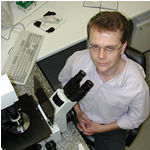 Dr Anthony Hannan Dr Anthony Hannan
Huntington's
disease is a fatal brain disorder that affects over 1,000 Australians,
with another 6,000 at risk from the disease. It is caused by a genetic
mutation, passed from parent to child, which results in major
disruption to normal movement, memory, thought processes and emotions,
eventually leading to death.
A research team, lead by Dr
Anthony Hannan from Australia's Howard Florey Institute, has found that
the onset and progression of the disease can be delayed by providing a
stimulating environment to those with the gene. This work has lead to a
greater understanding of the interaction between genes and the
environment - resulting in far reaching implications for other brain
diseases such as Alzheimer's.
The Huntington's disease gene
was isolated in 1993, yet little is still known about how the gene
mutation (a type of 'genetic stutter') actually causes the disease. Dr
Anthony Hannan had the idea that the disease symptoms might be caused
by abnormal connections between the neurons in particular parts of the
brain. He thought that changing the way these connections were used may
change the way the disease progressed.
To test this theory,
Dr Hannan and colleagues used transgenic mice - which had part of the
human Huntington's gene, which causes the disease, inserted into their
DNA with genetic engineering. One group of transgenic mice lived in an
enriched environment, having tunnels and a variety of different toys,
which were changed regularly, to play with. The other transgenic group
had no environmental enrichment at all.
The research showed
that, after 18 weeks, 100% of the mice that had no enrichment showed
symptoms of the disease. However, after the same length of time, only
15% of the mice that had a stimulating environment had developed
symptoms of the disease. This work demonstrated that environmental
factors play an important role in the onset and progression of the
disease.
Following this discovery, Dr Hannan and his team
have gone on to explore how genes and the environment interact in the
brain at molecular and cellular levels. Dr Hannan hopes that this will
lead to development of a new class of therapeutic drugs, which he has
called 'enviromimetics' that may mimic or enhance the beneficial
effects of environmental stimulation. Dr Hannan's research has also
inspired new occupational therapy programs for families suffering from
Huntington's disease.
Dr Anthony Hannan has entered his research in the 2005 British Council Eureka Prize for Inspiring Science.
Links:
http://www.hfi.unimelb.edu.au/
http://www.news-medical.net/?id=9601
http://www.aar.com.au/pubs/bt/2mar04/bio07.htm
back
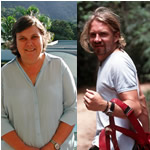 Dr Miriam Goosem & Nigel Weston Dr Miriam Goosem & Nigel Weston
The
increasing number of roads criss-crossing the rainforests of Northern
Australia has taken its toll on the native animals that live there.
Take the endangered Cassowary and rare Lumholtz's tree-kangaroo, for
example, where road deaths are causing a serious threat to species
survival. Pipelines, electric power lines and artificial clearing are
also causing havoc by fragmenting habitat, and hindering once viable
populations by preventing animal movements and thereby restricting
genetic diversity.
Scientists from the Rainforest CRC have
shown that by building tunnels under the road, and bridges over them,
many native animals can resume life as normal.
Building
tunnels under roads for native animals to use as crossings is not a new
idea, however little was known about how well they worked for
rainforest animals. Building hanging bridges over the road to connect
adjacent canopies is a new idea and Dr Miriam Goosem and Mr Nigel
Weston from the Rainforest CRC have done research to determine just how
effective these under and over passes are in saving the lives of native
animals.
Dr Goosem worked together with Queensland
Department of Main Roads, National Parks and Wildlife and various
conservations groups to choose sites for under and over passes on the
Atherton Tablelands. The sites were chosen because they provided a
unique opportunity to connect isolated parts of the rainforest and were
most likely to provide habitat continuity for animals.
Tunnels
were constructed under the road, with detailed consideration given to
the 'furniture' inside the tunnel to provide protection from predators.
The tunnel was floored with local soil, with rocks and logs to provide
shelter for small animals and ropes and branches allowed tree-living
animals to escape from ground level. For canopy dwelling animals that
seldom descend to the ground, a simple rope-bridge was provided so they
could cross above the road.
Animal traffic using the under
and over passes were monitored by researchers using sophisticated
sensors, automatic cameras and simple brushed sand floors to record
animal footprints.
The research showed that the under and
over passes were effective in reducing roadkill as well as providing
habitat continuity, and the design details are now being incorporated
into road upgrades throughout Australia.
Dr Goosem and her team have entered their research in the 2005 Sherman Eureka Prize for Environmental Research.
Links:
http://www.rainforest-crc.jcu.edu.au/publications/infosheets/faunalUnder.pdf
http://www.rainforest-crc.jcu.edu.au/publications/infosheets/CanopyBridges.pdf
http://www.rainforest-crc.jcu.edu.au/research/project4.2.htm
back
 Dr Derek Abbott Dr Derek Abbott
We
all know the saying "two wrongs don't make a right." Interestingly, if
you look around you, there are many examples to the contrary. For
example, engineers know that two unstable systems, if combined the
right way, can become stable; chess players know if they sacrifice
pieces they can win the overall game; and biologists know that animal
species sometimes decline in order to evolve to a higher level of
survival fitness.
Australian scientist Dr Derek Abbott has
taken this counter-intuitive phenomenon one step further to prove that
if you play two losing gambling games one after the other, you
eventually win!
Dr Abbott set out by computer simulating two gambling
games (A & B) with coins weighted on one side-so they did not fall
evenly by chance.
In game A, a player tosses a single weighted coin and bets on each throw. The probability of winning is less than half.
In
game B, a player tosses one of two weighted coins with a simple rule
added. He plays Coin 1 if his money is a multiple of a particular whole
number, like three. If his money cannot be divided by the number three,
he plays Coin 2. In this setup, the second coin will be played more
often than the first.
Both game A & B are loaded to
lose; one to lose badly and one to win slightly but lose overall, with
the upshot being that anyone playing these games individually will
eventually lose all their money.
Dr Abbott showed that
when a person plays either game (A or B) 100 times, money taken to the
gambling table is lost. But when the games are alternated, playing A
twice then B twice for 100 times, money accumulates into big winnings.
Dr Abbott also found that even if game A and B are played randomly,
with no order in alternating the sequence, winnings also go up and up.
This
is Parrondo's paradox. Dr Abbott with his colleagues showed that the
switching between the two games creates a ratchet-like winning effect. (Click here for a picture that might help you understand this phenomenon at work)
Following
Dr Abbott's work, many questions are being asked about this new
mathematical understanding and how it can help in other areas of
research such as in economics, population genetics, control theory,
gene dynamics, quantum computation and more.
Dr Abbott has entered his research in the 2005 Skeptics Eureka Prize for Critical Thinking.
Links:
http://www.eleceng.adelaide.edu.au/Groups/parrondo/
back
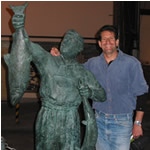 Dr John Kalish Dr John Kalish
Have
you ever wondered how to tell the age of a fish? Dr John Kalish is an
Australian scientist who has developed a technique that uses the
fall-out from nuclear bomb testing to accurately age long-lived fish
species.
All fish have ear bones, called otoliths, which
continuously grow over their lifetime by laying down bony calcified
material at different rates throughout the year (faster in summer,
slower in winter). The result is a banding pattern on the otolith,
similar to the growth rings of a tree. Scientists have used these bands
to determine the age of fish, however, the bands can't always be seen,
and are not always deposited annually, resulting in many inaccuracies.
Dr Kalish found that the fallout from nuclear weapons testing during the 1950's and 1960's left a chemical marker, radiocarbon (14C),
which could be detected in the otolith. Radiocarbon is produced by
natural processes in the Earth's upper atmosphere, but atmospheric
tests of nuclear weapons doubled the amount of radiocarbon in the
atmosphere in less than 10 years. The radiocarbon from the atmosphere
is transferred into the ocean.
Previous research had shown
that the concentration of radiocarbon in coral increased by 20% between
1950 and 1970 indicating how much radiocarbon from nuclear fallout has
moved from the atmosphere to the ocean. Dr Kalish found a very similar
phenomenon in otoliths. So, by selecting otoliths from fish that were
born during this period of increased radiocarbon and measuring
radiocarbon in segments of the otolith formed soon after birth, the
fish's true age could now be determined. A scientific instrument called
an accelerator mass spectrometer is used to make these measurements.
Over
the past seven years, Dr Kalish has used this technique to determine
the age of over 30 commercially important fish species including the
southern bluefin tuna - which he found live almost twice as long as was
previously thought. The research also provided clear evidence that some
of the fish we eat live for more than 100 years.
With 25%
of fish stocks now overexploited, the sustainable management of our
global fisheries has never been more important. Knowing how old fish
are is essential for estimating the productivity of fish populations
and determining the sustainable level at which they can be harvested.
Dr Kalish's work has been entered in the 2005 Sherman Eureka Prize for Environmental Research.
Links:
http://www.imr.no/english/news/2004/a_flight_recorder_in_the_ear
http://www.reef.crc.org.au/research/fishing_fisheries/fishage.htm
http://www.spc.org.nc/OceanFish/Html/TEB/Otolith/Otolith.htm
http://www.marinebiodiversity.ca/otolith/english/nuclear.htm
http://www.floridamarine.org/features/view_article.asp?id=21978
back
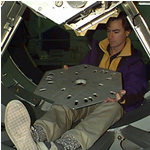 Dr Peter Tuthill Dr Peter Tuthill
Dr
Peter Tuthill from the University of Sydney has pioneered a new imaging
experiment which has revealed stars at their most crucial (and
beautiful) stages of life. His work is a fascinating mix of new
technology and a few key ideas from the past.
Stars, like
people, jealously guard the privacy of important life events. Stellar
births and deaths are covered in plumes and shells of gas and dust, and
all the action takes place on a stage so remote that very high
magnifications are needed to reveal any detail. Capturing a clear image
is fraught with difficulties, for as first described by Newton, the
turbulent mixing of the atmosphere in the air above the telescope
causes images to shimmer and degrade. Over the years, huge sums of
money have been invested in high-tech approaches such as space
telescopes to try to overcome this problem.
Dr Peter
Tuthill from the University of Sydney has successfully captured the
closest view yet of a star being born by using a technique first
conceived 130 years ago by a French optician called Fizeau, known as
aperture masking. Fizeau suggested placing a mask over the telescope
mirror which only allowed light to pass through two small holes.
Careful measurements of the image produced, he argued, would enable
fine detail up to the theoretical limit (known as diffraction limit) to
be recovered.
Using the world's largest optical
telescope, the Keck observatory in Hawaii, Dr Tuthill designed an
aluminium plate that was mounted onto the telescope that blocked off
most of the light coming in, except for a handful of starlight beams.
This made the telescope mirror behave like an array of small
telescopes, which in turn had a profound effect on the ability to
recover an image. The aluminium plate, acting as a mask, simplified the
process by sorting out which parts of the image came from which beams
of starlight, effectively reducing background noise and confusion.
Dr
Tuthill also used state of the art infrared array detectors to record
data electronically, which were then processed using sophisticated
mathematical and statistical techniques.
By combining the
old and the new, Dr Tuthill achieved a resolution of one 20,000th of a
second of arc - that's equivalent to seeing the head of a pin in detail
at a distance of five kilometres away. This technology has revealed the
fascinating and beautiful structures of stars being born and the plumes
and shrouds which envelope a star as it dies. It has also revealed a
wealth of astrophysical secrets about star structure and history.
Dr Peter Tuthill has entered his research in the 2005 UNSW Eureka Prize for Scientific Research.
Links:
http://www.physics.usyd.edu.au/~gekko/gekko.html
back
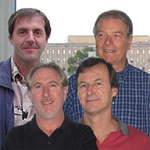 Conotoxin Research Team Conotoxin Research Team
Professor Paul Alewood, Professor David Adams, Professor David Craik & Associate Professor Richard Lewis.
Australia
has many different types of carnivorous cone snails (Conus spp) that
live in our oceans. The snails hunt their prey (usually fish, worms and
other molluscs) by firing potent venom from a harpoon-like organ,
causing paralysis and death in seconds.
A group of
Australian scientists have been investigating these venoms, called
conotoxins, and have found some to have outstanding pain-killing
properties.
The Conotoxin Research Group is made up of
chemists, biologists, pharmacologists and physiologists. This group was
one of the first, world wide, to recognize the potential use of venoms
and toxins as molecular templates for drug design, and as research
tools to help understand how nerve cells function.
The
venom of any one snail can contain up to 200 peptides. Peptides are
small protein fragments that exhibit powerful, highly selective
activity on nerves. The Conotoxin Group has isolated, identified and
characterized (both structurally and pharmacologically) many venom
peptides, and has helped develop a classification system for each
family of peptides, based on their source, structure and
pharmacological affects.
Conotoxins interfere with the ion
channels and membrane-bound proteins in the nerve cell, which in turn
disrupts the nerve cells function. By studying the interaction between
conotoxins and these ion channels and proteins, the Group has made
significant advancements in our knowledge of the nervous system and
management of chronic pain.
The work of the Conotoxin Group
has also resulted in a successful "spin-off" company called Xenome. The
company has taken a number of the venom peptides to both preclinical
and clinical stages with some promising results for the development of
new drugs for the management of pain.
The Conotoxin
Research Group has entered their research in the 2005 Royal Societies
of Australia Eureka Prize for Interdisciplinary Scientific Research.
Links:
http://www.xenome.com/
http://grimwade.biochem.unimelb.edu.au/cone/
back
|